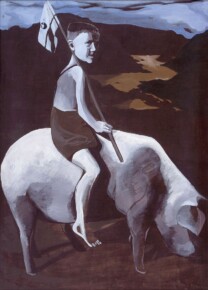Art in Poland and Public Affairs, 1966-1994
Works from the collection of the Museum of Modern Art in Radom – branch of the Jacek Malczewski Museum. The exhibition – organised on the 20th anniversary of Polish independence tells about the art and the Poland of the last 40 years.
It presents almost 130 works by over 52 artists – paintings, sculptures, drawings, prints and one installation from the collection of the Radom museum. Those are works by artists from various generations, presenting various trends outstanding works, important testimonies of time. In those days, their authors were concerned with social, political and ethical subjects which in public debate could not be touched upon in any other way. Among the exhibitions there are works referring to important dates in Polish calendar: March 1968, December 1970, June 1976, the period from August 1980 till December 13th, 1981, the year 1989. They’re an expression of free thought, one’s own political and social beliefs. There are also works that are equally important for the concept of the exhibition, but they don’t refer to any particular events, they deal with significant ethical and metaphysical issues. (Tracing those metaphors is particularly interesting.)
The works have been organised chronologically. The earliest work was created in 1966 – it’s also the date of the first WPROST exhibition in Krakow (with participation of Maciej Bieniasz, Zbylut Grzywacz, Barbara Skąpska, Leszek Sobocki and Jacek Waltoś). There’s the art from the break of 1960s and 1970, from the second half of 1970s, the years 1980-1981, the times of martial law and the years of regaining the independence. The works refer to the the-current political situation; sometimes, they mock the official propaganda, discuss the situation of women, national tradition, but also the World War II and the Vietnam War. The narration is closed in 1994, when Edward Dwurnik – a chronicler of those years – finished painting his “From December To June” cycle, devoted the casualties of martial law. (However, the exhibition’s punch line is in the works from later years, presenting the continuation of Polish history, the most recent work was created in 2008.)
The artists were looking for a metaphor that would depict the Polish situation. Now, from the perspective of the years, those paintings, sculptures and drawings are a record not only of the social and political situation of those years, but also of the existential one; we sense a universal meaning.
The artists whose works are presented at the exhibition are:
Sylwester Ambroziak, Grzegorz Bednarski, Jerzy Bereś, Maciej Bieniasz, Henryk Błachnio, Tadeusz Boruta, Krystyna Brzechwa, Jerzy ćwiertnia, Jerzy Duda-Gracz, Edward Dwurnik, Barbara Falender, Antoni Fałat, Stanisław Fijałkowski, Eugeniusz Get-Stankiewicz, Zbylut Grzywacz, Adam Hoffmann, Krzysztof Jackowski, Andrzej Kalina, Jerzy Kalina, Ewa Kierska, Łukasz Korolkiewicz, Jerzy Krawczyk, Wiesław Kruczkowski, Ryszard Lis, Zbysław Marek Maciejewski, Krzysztof Mańczyński, Aldona Mickiewicz, Mariusz Mikołajek, Eugeniusz Mucha, Zdzisław Nitka, Andrzej Okińczyc, Władysław Paciak, Maria Pinińska-Bereś, Jerzy Puciata, Marek Sapetto, Jacek Sienicki, Barbara Skąpska, Hieronim Skurpski, Marek Sobczyk, Leszek Sobocki, Jonasz Stern, Andrzej Strumiłło, Paweł Susid, Maciej Szańkowski, Barbara Szubińska, Witold Urbanowicz, Krzysztof Wachowiak, Jacek Waltoś, Mieczysław Wejman, Ryszard Woźniak
The Museum of Modern Art in Radom was established as a branch of the Radom Regional Museum in 1990 (and was the first Polish museum to officially get such a name). It began operations in May 1991; in 1992, the museum started collecting donations for the first Polish museum of modern art. Thanks to that action, the collection increased by almost 2500 works (at the moment, the collection of post-1945 art is almost 4500 works). So it’s an institution that was established during the period of the first government of the Third Republic and expanded its collection as a result of the activities of the civil society – due to enormous involvement of artists, intellectuals in creating a new cultural institution in the democratic country.
Mieczysław Szewczuk


